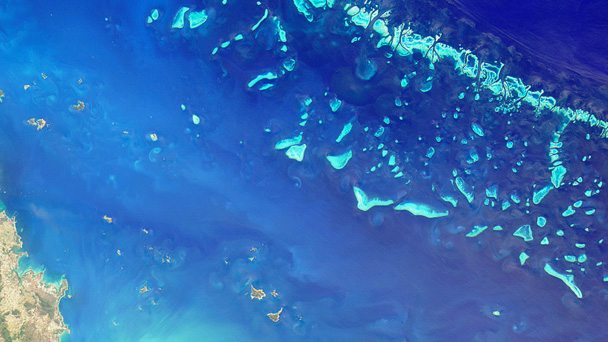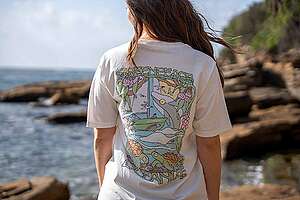The United Nations is concerned about port expansions and dredging disposal in the Great Barrier Reef – but that bigger picture is ignored in new ‘Reef Facts’ commercials. -By Jon Brodie, James Cook University

Image courtesy NASA/GSFC/LaRC/JPL, MISR Team, CC BY
New “Reef Facts” commercials are currently airing during prime-time television shows in Australia, purporting to tell the “facts” about the environmental health of the Great Barrier Reef. It comes amid growing international concerns – including from the United Nations overnight – about the future of the reef.
The context for these ads is the contentious expansion of the Abbot Point coal port, which will see three million cubic metres of dredge spoil dumped within the Great Barrier Reef Marine Park. And there is a lot more dredging and dumping being proposed – so much, in fact, that the Great Barrier Reef Marine Park Authority said in a recent 636-page report:
The increase in the number of proposals for new and expanded ports along the Great Barrier Reef coast is of particular concern. There is also an increase in requests for dredging to extend outside of port exclusion areas and into the Marine Park — for example dredged entrance channels to allow for larger draft ships to access ports such as Townsville and Hay Point. The Authority has identified risks from the proposed port developments to the inshore area of the Region, which have the potential to cause significant negative impacts on species and habitats critical to the healthy functioning of the Reef’s ecosystem.
In yet another sign of international concern about the Abbot Point dumping decision, overnight the United Nations Educational, Scientific, and Cultural Organization (UNESCO) has expressed “concern” and “regret” about recent approvals for major industrial projects on the reef, particularly the approval of Abbot Point dredge disposal within the marine park, “despite an indication that less impacting disposal alternatives may exist”. (Scroll down to page 102 of that link. You can also read my analysis of disposal alternatives here.)
The UN’s World Heritage Committee is now expected to decide whether to list the Reef as a “World Heritage Site in Danger” in February next year.
It’s important to be clear upfront: dredging is not the most significant threat to the Great Barrier Reef’s future. Discussing that would require a whole other article about climate change and countless other factors.
But the truth is not as simple as these QRC ads make out. So let’s get the facts straight on the Great Barrier Reef.
What the ads don’t tell you
The ads – which you can watch below or on the QRC website – say that:
No scientific study has blamed ports or shipping for coral loss, or a decline in the environmental health of the Great Barrier Reef.
Paid for by the Resources Council, both ads end by pointing to a Queensland government Reef Facts website.
Reef Facts TVC 30 second from QRC on Vimeo.
The basis for the statistics in the two QRC ads come from an excellent 2012 peer-reviewed paper, “The 27–year decline of coral cover on the Great Barrier Reef and its causes”, published in the international journal Proceedings of the National Academy of Sciences.

The 2012 study that the QRC ads quotes from.
CC BY
The paper found, just as the ad shows, that 48% of coral death was attributed to cyclones, 42% to crown of thorn starfish and 10% to bleaching.
But the way that those facts are used in the ads is highly misleading.
The data in the 2012 study come from coral reefs predominantly on the mid-shelf of the Great Barrier Reef – that is, 30 to 100 kilometres from the coast.
The study does not address the causes of death and decline among inshore reefs, seagrass meadows, dugongs, turtles and inshore dolphins. All these ecosystems and species are also in decline, with inshore coral reefs – those found up to 40km from the coast – seagrass and dugongs in severe decline in most of the reef south of Cooktown.
It is misleading for these ads to selectively quote one study that only looks at coral mortality on mid-shelf reefs, and then claim that shipping and port activity has no impact on “the environmental health of the Great Barrier Reef”.
The Great Barrier Reef: more than coral
It might seem like a statement of the obvious, but the Great Barrier Reef is not only world-famous – and World Heritage-listed – because of its coral. To borrow from Bill Clinton’s famous campaign line: it’s the ecosystem, stupid.
The largest living structure on Earth, it spans 2300km and is home to 600 types of coral, more than 100 species of jellyfish, 500 species of worms, 1625 types of fish, 133 varieties of sharks and rays, 14 breeding species of sea snakes, 215 species of birds, six of the world’s seven species of marine turtle, 30 species of whales and dolphins, and one of the world’s most important dugong populations.
Protecting mid-shelf coral reefs is important. But unlike the QRC ads, most studies on threats to the Great Barrier Reef consider threats to the complete range of species and ecosystems that make it so unique.
The main water-quality threats to these ecosystems are sediment, nutrients, pesticide, toxic metals and hydrocarbons from the land. These come from agricultural activities and from coastal development – including ports.
So is it true, as the ad claims, that:
No scientific study has blamed ports or shipping for coral loss
In fact, the very limited coral monitoring that has occurred associated with dredging at Gladstone Harbour has suggested some changes to the benthic communities (organisms living on the sea floor, such as sponges and corals) in the area. But as with so much of the monitoring, the design of the study was not robust enough to firmly ascribe the actual cause.
So without more scientific evidence, it’s impossible to fairly conclude whether any coral loss can be attributed to ports or shipping activity.
However, the ads make a broader claim that:
No scientific study has blamed ports or shipping for … a decline in the environmental health of the Great Barrier Reef.
And this is where the ads really don’t tell the full story.
Independent scientific studies – as in, independent from the Queensland government and Gladstone Port Corporation – have linked extensive finfish, crabs, prawns and shark disease and death with the dredging of contaminated sediments in Port Curtis at Gladstone in 2011 and the leakage of the most contaminated component of the dredge spoil from a poorly constructed, monitored and maintained bunded retention area.

Ports along the Great Barrier Reef coastline.
Great Barrier Reef Marine Park Authority Draft Strategic Assessment Report, CC BY
Environmental management was so poor at Gladstone that several inquiries have been set up to investigate, the most recent one by federal environment minister Greg Hunt, which was recently extended. Its findings should be released soon.
That inquiry came after years of local concern over the outbreak of fish disease and claims of cover-ups non-reporting of a leaking bund wall, non-reporting of exceedences of water quality guidelines, and other problems.
Further north at the Hay Point coal terminal near Mackay, large-scale capital dredging in 2006 led to considerable loss of deepwater seagrass, which recovered somewhat by 2007 but had not recovered well in the period to 2011, most likely due to the combination of the dredging impacts and further impacts of extreme weather.
The authors of the reports on the Hay Point seagrass monitoring program noted the vulnerability of this type of Halophila decipiens seagrass to disturbance, especially when such disturbances occur regularly, which has a cumulative effect.
Get the facts
So should the QRC be declaring so absolutely in its TV ads that:
No scientific study has blamed ports or shipping for coral loss, or a decline in the environmental health of the Great Barrier Reef.
Based on my knowledge of the science: no.
Several robust studies have now established that dredging and spoil dumping on a large scale have had impacts on species and ecosystems of the Great Barrier Reef World Heritage Area.
And that’s concerning, given the likelihood of further massive dredging programs potentially generating up to 80 million tonnes of dredge spoil, which presents a significant threat to the inshore ecosystems and species of the Great Barrier Reef.
![]()
Jon Brodie does not work for, consult to, own shares in or receive funding from any company or organisation that would benefit from this article, and has no relevant affiliations.
This article was originally published on The Conversation.
Read the original article.


